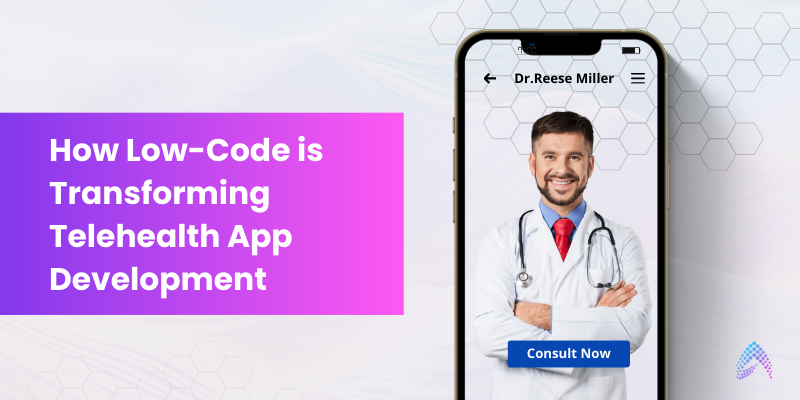How Low-Code is Transforming Telehealth App Development

The healthcare industry has seen an unprecedented IT boom in recent years, driven by the need for better patient care and streamlined services. Telehealth has become an indispensable component of modern healthcare, offering convenient and accessible care to patients, especially those residing in remote or underserved regions. In fact, according to a recent study, telehealth adoption surged by over 50% during the pandemic, and this trend shows no sign of slowing down.
With this surge in healthcare IT, low-code development platforms have emerged as a game-changer in this space, enabling healthcare providers to create sophisticated telehealth applications with minimal coding effort. By leveraging low-code, healthcare organizations can accelerate development cycles, reduce costs, and increase agility in response to evolving patient needs. In this blog post, we will delve into the key benefits of using low-code for telehealth app development, discuss essential features to consider, and provide insights into successful implementation strategies.
Understanding Low-Code Development for Telehealth
Low-code development platforms utilize a visual interface and pre-built components, reducing the need for extensive coding. This allows developers, and even non-technical users, to create complex applications with minimal effort. For telehealth, this means:
- Rapid Application Development: Quickly build and deploy telehealth apps to meet urgent healthcare needs.
- Flexibility and Scalability: Easily adapt apps to changing requirements and accommodate growing patient volumes.
- Integration Capabilities: Seamlessly integrate with existing healthcare systems, such as electronic health records (EHRs) and medical devices.
- Cost-Effectiveness: Reduce development time and costs, making telehealth more accessible to healthcare providers of all sizes.
By leveraging low-code, healthcare organizations can significantly shorten the time-to-market for their telehealth initiatives, enabling them to provide critical care services to patients more quickly. See how AI-driven low-code can transform another healthcare aspect, clinical trials: Read the blog
Essential Features of Low-Code Telehealth Apps
A successful telehealth app should incorporate several essential features to provide a comprehensive and effective patient experience. These include:
Video Conferencing:
- Real-time interactions: Enable face-to-face consultations between patients and healthcare providers, fostering trust and improving patient satisfaction.
- High-quality video and audio: Ensure clear and reliable communication, even in areas with limited internet connectivity.
- Secure connections: Protect patient privacy by using encrypted video conferencing technology.
Messaging and Chat:
- Asynchronous communication: Allow patients to send messages to their healthcare providers at their convenience, reducing wait times and improving accessibility.
- Quick response times: Enable healthcare providers to respond to patient inquiries promptly, enhancing patient satisfaction.
- Integration with EHRs: Automatically link messages to patient records for a comprehensive view of patient interactions.
Electronic Prescriptions:
- Reduce medication errors: Minimize the risk of prescription errors by automating the prescription process.
- Improve patient safety: Ensure that patients receive the correct medications promptly.
- Streamline workflows: Simplify the prescription process for healthcare providers and pharmacies.
Patient Portals:
- Empower patients: Provide patients with access to their medical records, appointments, and test results, enabling them to take an active role in their healthcare.
- Improve patient engagement: Foster a more collaborative relationship between patients and healthcare providers.
- Enhance care coordination: Facilitate seamless communication between patients, healthcare providers, and other members of the care team.
Remote Monitoring:
- Proactive care management: Track patient health metrics from a distance, allowing early intervention and prevention of adverse health events.
- Improve patient outcomes: Enhance patient health and well-being by providing timely care.
- Reduce hospitalizations: Prevent unnecessary hospitalizations by identifying and addressing health issues early.
Integration with EHRs:
- Seamless data exchange: Ensure that patient data is seamlessly transferred between telehealth apps and EHR systems.
- Comprehensive patient records: Maintain a complete and accurate record of patient interactions and health data.
- Improved care coordination: Facilitate better communication and collaboration among healthcare providers.
Best Practices for Building Low-Code Telehealth Apps
When building a telehealth app using low-code, following best practices ensures a smooth development process and a high-quality solution. Here are some key considerations:
- Prioritize User Experience: Design intuitive and user-friendly interfaces that cater to both patients and healthcare providers.
- Ensure Security and Privacy: Implement robust security measures to protect patient data and comply with regulations like HIPAA.
- Consider Accessibility: Make sure your telehealth app is accessible to users with disabilities by adhering to accessibility guidelines.
- Optimize for Mobile: Ensure compatibility with smartphones and tablets for enhanced accessibility and convenience.
- Continuously Test and Improve: Regularly test the app, gather user feedback, and make necessary updates to improve functionality and user satisfaction.
Choosing the Right Low-Code Platform
Selecting the right platform is crucial to the success of your telehealth app. Look for features such as:
- Ease of Use: Choose a platform that enables quick development, even for non-technical users.
- Scalability: Ensure the platform can handle increasing patient loads as your organization grows.
- Integration Capabilities: Verify the platform integrates seamlessly with existing healthcare systems like EHRs and medical devices.
- Security: Opt for a platform with robust data protection and compliance features to safeguard patient information.
- Customization: Look for a platform that allows for customization to meet the specific needs of your telehealth app.
By keeping these factors in mind, you can build a telehealth solution tailored to your unique requirements. If you’re unsure about where to start or need expert guidance in selecting and implementing the right platform, our team is here to help.
Potential Use Cases: Low-Code Telehealth Apps in Action
To demonstrate the versatility of low-code platforms in telehealth app development, let’s explore a few potential use cases where low-code could be applied to address critical healthcare challenges:
Chronic Disease Management
In rural areas, healthcare providers could use low-code platforms to develop telehealth apps tailored for patients with chronic diseases like diabetes and hypertension. These apps could allow patients to monitor their health metrics, schedule appointments, and communicate directly with healthcare providers. By adopting such a solution, organizations could potentially improve patient outcomes and reduce the need for hospitalizations.
Patient Education
In healthcare facilities dealing with high patient volumes, low-code platforms can be instrumental in creating scalable, personalized educational apps, empowering patient education. These apps, developed quickly using low-code tools, provide interactive and engaging content tailored to individual patient needs. By leveraging AI, these apps can further enhance personalization, offering real-time support and tailored educational materials. This approach addresses key challenges like time constraints, lack of personalization, and misinformation, ensuring patients receive relevant and understandable information, ultimately improving their health outcomes.
Mental Health Services
A mental health clinic in remote areas could leverage low-code telehealth apps to provide therapy sessions to patients. These apps would enable patients to connect with therapists via video conferencing and receive personalized treatment plans. This approach could help increase access to mental health services and reduce the stigma associated with seeking mental health care.
Urgent Care Services
A mental health clinic in remote areas could leverage low-code telehealth apps to provide therapy sessions to patients. These apps would enable patients to connect with therapists via video conferencing and receive personalized treatment plans. This approach could help increase access to mental health services and reduce the stigma associated with seeking mental health care.
Clinical Trials
For research institutions, low-code platforms offer a powerful solution for managing participant data and streamlining processes while conducting clinical trials. Developing an app with low-code tools can simplify participant enrollment, progress tracking, and data collection. Integrating AI can enhance these capabilities by analyzing data trends and providing actionable insights, which helps in managing trials more efficiently and accurately. This method accelerates research, improves data quality, and supports more effective decision-making throughout the trial process.
Conclusion
Low-code development platforms have emerged as a powerful tool for healthcare providers seeking to expand their reach and improve patient outcomes through telehealth. By leveraging low-code, organizations can rapidly build and deploy sophisticated telehealth applications, reducing development time, costs, and complexity.
As demonstrated by the use cases presented in this blog post, low-code telehealth apps can significantly improve healthcare delivery by:
- Expanding access: Reaching patients in remote or underserved areas.
- Enhancing outcomes: Providing timely and effective care.
- Reducing costs: Lowering healthcare expenses.
- Streamlining operations: Improving efficiency and productivity.
How Does Low-Code Development Work?
Low-code development platforms utilize a visual interface and pre-built components, reducing the need for extensive coding. This allows developers and even non-technical users to create complex applications by dragging and dropping elements onto a canvas and configuring their properties. This approach significantly speeds up development time and reduces the need for specialized technical skills.
Challenges and Limitations
While low-code development offers numerous benefits, it’s important to consider potential challenges and limitations:
- Customization Limits: While low-code platforms provide a high degree of flexibility, there may be limitations in terms of customization for highly complex or specialized applications.
- Scalability Concerns: As telehealth usage grows, ensuring that low-code apps can scale to handle increased demand may require careful planning and optimization.
- Vendor Lock-in: Relying heavily on a specific low-code platform may create vendor lock-in, limiting flexibility and potentially increasing costs.
Despite these challenges, low-code platforms remain a valuable tool for healthcare providers looking to improve patient care through telehealth. By carefully evaluating their needs, organizations can leverage low-code to build innovative, scalable telehealth solutions.
If you’re a healthcare organization looking to capitalize on low-code for your telehealth initiatives, Amzur is here to assist. Our team of experts can help you select the right platform, design and develop your telehealth app, and ensure a seamless implementation.
For further insights into how IT-driven process automation can revolutionize healthcare operations, download our comprehensive guide, Transforming Healthcare Efficiency: A Practical Guide to IT-Driven Process Automation.
Contact us today to discuss your requirements and discover how we can help transform healthcare delivery.

President & CEO – Growth Markets




